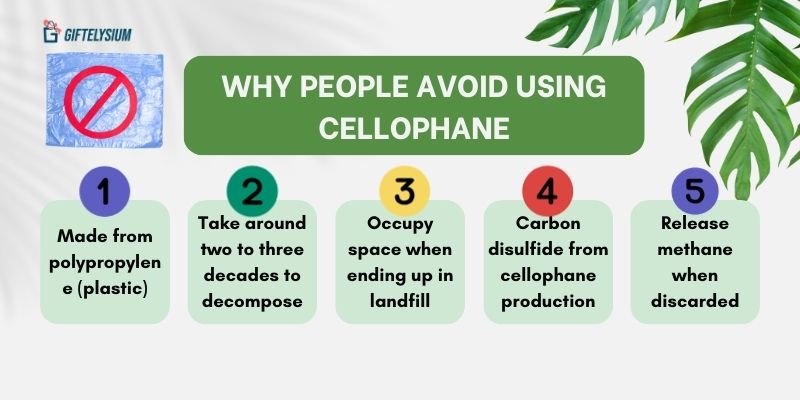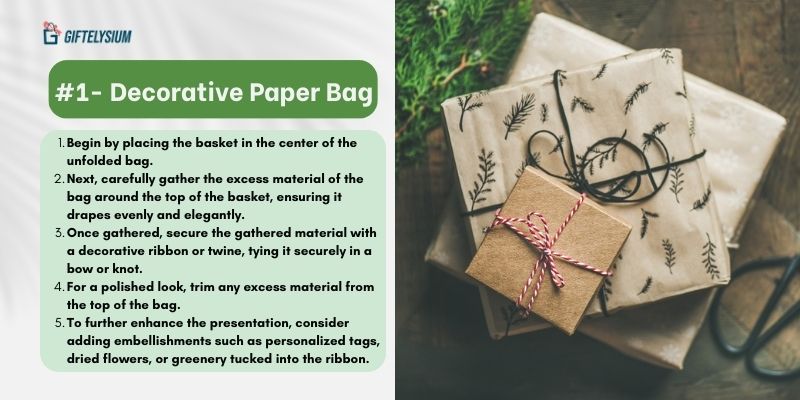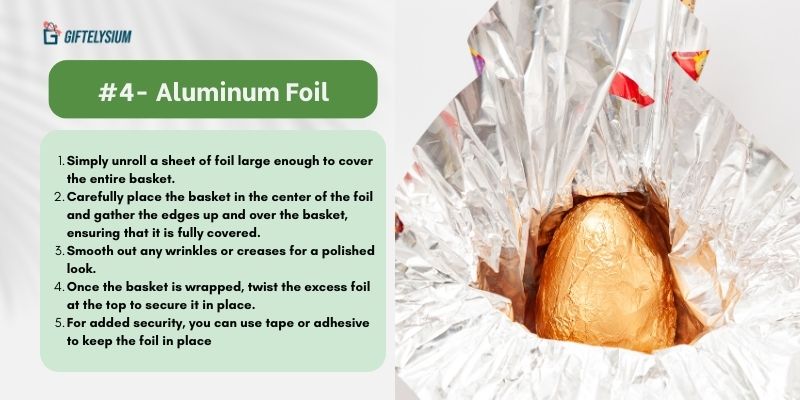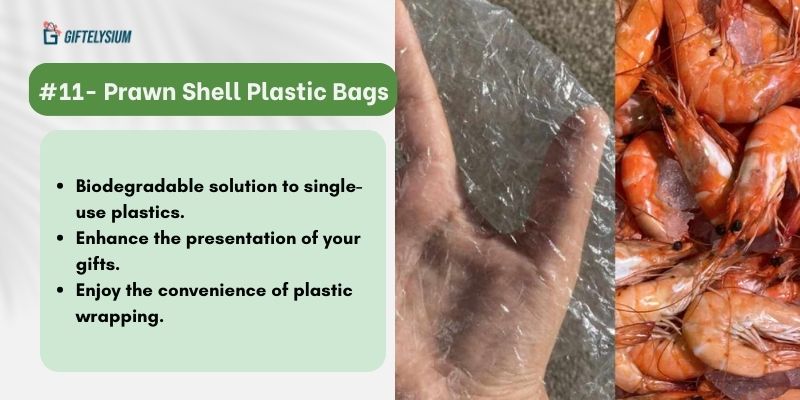Traditionally, cellophane served as the go-to wrapping material for gift baskets, but its environmental impact and non-recyclable nature have prompted us to seek creative alternatives. However, how to wrap a gift basket without cellophane can be quite the puzzle.
In this blog, GitfElysium will introduce 12 remarkable ways to wrap gift baskets sustainably—because eco-conscious gifting is not only thoughtful but also kind to our planet. Let’s dive into the art of wrapping without cellophane!
The Environmental Impact of Cellophane
Cellophane, a versatile material used for food preservation, gift wrapping, and product packaging, has both positive and negative aspects in terms of environmental impact.
- Composition and Production: Synthetic cellophane is made from polypropylene, a type of plastic. While it’s recyclable, it doesn’t break down as quickly as true cellophane.
- Biodegradability: Synthetic cellophane, being plastic-based, takes longer to decompose—around two to three decades. It’s better suited for recycling than composting.

Why People Avoid Using Cellophane
- Landfill Impact: When cellophane ends up in landfills, it occupies space without breaking down rapidly. Carbon disulfide, used in cellophane production, poses environmental risks.
- Methane Emission: If cellophane is discarded in landfills without proper methane recovery systems, it may release methane, a potent greenhouse gas.
These impacts are the primary drivers behind people seeking alternatives for how to wrap a gift basket without cellophane.
12 Eco-Friendly Alternatives to Cellophane for Wrapping Gift Baskets
1. Decorative Paper Bag
Decorative paper bags provide a wonderful eco-friendly option for wrapping gift baskets, offering both style and sustainability. Whether you opt for a classic brown kraft paper bag or a patterned one to suit the occasion, these bags elevate the presentation of your gift while minimizing environmental impact.
To expertly wrap a gift basket using a paper bag:

How to Wrap a Gift Basket with Decorative Paper Bag
- Begin by placing the basket in the center of the unfolded bag.
- Next, carefully gather the excess material of the bag around the top of the basket, ensuring it drapes evenly and elegantly.
- Once gathered, secure the gathered material with a decorative ribbon or twine, tying it securely in a bow or knot.
- For a polished look, trim any excess material from the top of the bag.
- To further enhance the presentation, consider adding embellishments such as personalized tags, dried flowers, or greenery tucked into the ribbon.
This wrapping method not only reduces waste but also adds a touch of rustic charm to your gift-giving endeavors, making it both visually appealing and environmentally conscious.
2. Towel
Towels serve as an innovative and environmentally conscious alternative to traditional cellophane when we find how to wrap a gift basket without cellophane. Beyond the gift itself, the towel becomes a part of the present, offering both practicality and sustainability. To expertly wrap a gift basket with a towel:

How to Wrap a Gift Basket with Towels
- Lay the towel flat on a surface and place the gift basket in the center.
- Fold one side of the towel over the basket, then fold the opposite side over, overlapping them slightly.
- Fold the remaining two sides over the basket, tucking in the corners neatly.
- Use a ribbon or twine to tie the gathered fabric at the top of the basket securely.
- Add a finishing touch with a decorative element like a sprig of greenery or a personalized tag.
Not only does this method look great, but it also encourages the recipient to reuse the towel, making it a win-win for both style and sustainability.
3. Tablecloth
A tablecloth presents a versatile and eco-friendly alternative to traditional cellophane, offering both elegance and sustainability. Utilizing a tablecloth for gift wrapping not only enhances the presentation but also repurposes an item that would otherwise go unused. To wrap a gift basket with a tablecloth:

How to Wrap a Gift Basket with A Tablecloth
- Choose a tablecloth that matches the occasion or theme of your gift.
- Lay the tablecloth flat and place the gift basket in the center.
- Gather the edges of the tablecloth up and over the basket, covering it completely.
- Use safety pins to secure the tablecloth in place, adjusting the fit as needed.
- Tuck any excess fabric neatly for a polished look.
This method not only makes your gift look beautiful but also gives new life to a household item. It's a win-win for both style and sustainability!
4. Aluminum Foil
Aluminum foil offers a shiny and eco-friendly alternative for how to wrap a gift basket without cellophane, providing both visual appeal and sustainability. The reflective surface of aluminum foil adds a touch of elegance to any gift presentation, while also being recyclable and reusable. To wrap a gift basket with aluminum foil:

How to Wrap a Gift Basket with Aluminum Foil
- Simply unroll a sheet of foil large enough to cover the entire basket.
- Carefully place the basket in the center of the foil and gather the edges up and over the basket, ensuring that it is fully covered.
- Smooth out any wrinkles or creases for a polished look.
- Once the basket is wrapped, twist the excess foil at the top to secure it in place.
- For added security, you can use tape or adhesive to keep the foil in place.
This wrapping method not only enhances the visual appeal of your gift but also reduces waste by utilizing a recyclable material.
5. Pillowcase
Pillowcases offer a practical and charming eco-friendly option when we are looking for how to wrap a gift basket without cellophane. With their soft texture and variety of designs, pillowcases not only add a cozy touch to your gift presentation but also promote sustainability by repurposing household items. To wrap a gift basket with a pillowcase:

How to Wrap a Gift Basket with Pillowcases
- Start by laying the pillowcase flat and placing the basket in the center.
- Next, gather the edges of the pillowcase up and around the basket, ensuring that it covers the entire basket evenly.
- Once the basket is fully covered, gather the excess material at the top and secure it with a decorative ribbon tied in a bow or knot.
This method not only creates a visually appealing presentation but also encourages reuse, as the recipient can use the pillowcase for its intended purpose long after the gift has been unwrapped.
6. Scarf
Scarves are versatile and eco-friendly alternatives to traditional cellophane for wrapping gift baskets, offering both style and sustainability. With a wide variety of colors, patterns, and textures available, scarves provide endless possibilities for creating unique and personalized gift wraps. To use a scarf for wrapping a gift basket:

How to Wrap a Gift Basket with A Scarf
- Simply lay it flat on a surface and place the basket in the center.
- Then, fold the ends of the scarf over the basket, crossing them in the middle to create a bow-like effect.
- Adjust the folds as needed to ensure a snug fit around the basket, and tie the ends of the scarf into a bow or knot to secure it in place.
This method not only adds a decorative touch to your gift but also encourages reuse, as the recipient can wear the scarf long after the gift has been unwrapped, making it a thoughtful and sustainable choice for gift wrapping.
7. Shredded Paper
Wrapping gift baskets with shredded paper is an eco-friendly and charming alternative to using cellophane. Here's how to do it:

How to Wrap a Gift Basket with Shredded Paper
- Gather old magazines or books and shred their pages into small pieces.
- Fill the basket generously with the shredded paper to ensure the items inside are well-covered and protected.
- Layer the shredded paper to provide stability and visual interest.
- Add decorative elements like dried flowers, ribbon bows, or personalized tags among the shredded paper to enhance the presentation.
This method not only gives new life to old paper materials but also creates a visually appealing and environmentally friendly way to present your gifts.
8. Plant-Based Plastics
Plant-based plastics are emerging as a sustainable alternative to conventional cellophane for wrapping gift baskets, offering a combination of environmental benefits and practicality. Derived from renewable resources such as corn or sugarcane, these bioplastics are biodegradable, meaning they can naturally break down into harmless substances over time, unlike traditional plastics that persist in the environment for centuries.

Why You Should Choose Plant-Based Plastics Instead of Cellophane
By opting for plant-based plastics, you're choosing materials with a lower environmental impact, as they reduce reliance on fossil fuels and minimize carbon emissions during production. Furthermore, plant-based plastics maintain the convenience and versatility of conventional plastics while offering a more eco-friendly solution for packaging needs.
So, when wrapping your gift baskets with plant-based plastics, you're not only ensuring a beautiful presentation but also contributing to a healthier planet by reducing plastic pollution.
9. Shower-Friendly Paper
Shower-friendly paper stands out as a thoughtful and eco-friendly alternative to traditional cellophane for wrapping gift baskets, particularly when containing items susceptible to moisture, such as bath products. This specialized paper is crafted with water-resistant properties, ensuring durability and protection against water damage.

Why You Should Choose Shower-Friendly Paper Instead of Cellophane
By utilizing shower-friendly paper for your gift basket wrapping, you not only safeguard the contents from potential moisture exposure but also demonstrate a commitment to sustainability. This eco-conscious choice reduces reliance on single-use plastics, contributing to the conservation of natural resources and the mitigation of plastic pollution.
Moreover, shower-friendly paper maintains the aesthetic appeal of the gift presentation while prioritizing environmental responsibility. Embracing this eco-friendly option offers a win-win solution, enhancing the gifting experience while minimizing environmental impact.
10. Palm Leaves
Palm leaves represent a detailed and eco-conscious substitute for traditional cellophane in gift basket wrapping. Dried palm leaves can be repurposed in various ways: woven into intricate baskets or utilized directly as wrapping material.

Why You Should Choose Palm Leaves Instead of Cellophane
Their natural composition ensures they are biodegradable, meaning they break down harmlessly over time, reducing environmental impact. Embracing palm leaves as wrapping material not only elevates the aesthetic appeal of the gift presentation but also aligns with sustainability principles.
Their inherent rustic beauty adds a unique and charming touch to each gift basket, creating a memorable and environmentally friendly gifting experience. By choosing palm leaves, you're not only making a positive impact on the environment but also celebrating the beauty and versatility of natural materials in gift presentations.
11. Prawn Shell Plastic Bags
Prawn shell plastic bags are an innovative and eco-friendly alternative to traditional cellophane for wrapping gift baskets. Researchers have pioneered the development of plastic bags crafted from chitosan, a substance derived from prawn shells. These bags offer a biodegradable solution to single-use plastics, addressing concerns about environmental pollution.

Why You Should Choose Prawn Shell Plastic Bags Instead of Cellophane
By utilizing chitosan-based plastic bags for gift basket wrapping, you're opting for a sustainable option that reduces reliance on non-biodegradable materials. Embracing this eco-conscious choice not only enhances the presentation of your gifts but also demonstrates a commitment to environmental stewardship.
With prawn shell plastic bags, you can enjoy the convenience of plastic wrapping while contributing to a cleaner and healthier planet.
12. Bagasse
Bagasse is also a notable eco-friendly alternative to traditional cellophane for wrapping gift baskets, owing to its sustainable and biodegradable properties. As a byproduct of sugarcane processing, bagasse offers a renewable and abundant resource for crafting biodegradable containers and packaging materials.

Why You Should Choose Bagasse Instead of Cellophane
By utilizing bagasse-based products for gift basket wrapping, you're opting for a sustainable option that reduces reliance on non-biodegradable materials. These biodegradable containers and packaging solutions not only provide a visually appealing presentation for your gifts but also contribute to environmental conservation efforts.
With bagasse, you can enjoy the convenience of modern packaging while minimizing your ecological footprint and promoting a greener future..
Conclusion
How to wrap gift baskets without cellophane is no more difficult with our 12 alternatives above. Remember, thoughtful wrapping enhances the gift-giving experience, showing your loved ones how much you care. So, explore these creative alternatives, and make your gifts stand out with sustainable and stylish wrapping.

